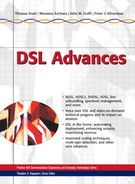5.7. Identification (I) Field
The identification field (or simply the I field) identified in Figure 5.4 contains four components as shown in Figure 5.7. The components are
Message Type Field (1 octet)
Revision Number Field (1 octet)
Vendor ID Field (8 octets)
Bit-encoded parameter field
Figure 5.7. Identification field structure.
![]()
The message type is one of the message or command types defined earlier. The message type list and the corresponding bit encoding are provided in Table 5.3.
The revision number field is a single octet that identifies the revision number of the G.994.1 Recommendation that the equipment conforms to. Note that the revision number is updated only when a structural change is made to the handshake protocol, for example, the addition of new command or message types. The addition of code points will not constitute a change in revision number.
The vendor ID field is an 8-octet field that identifies the manufacturer of the handshake functionality, which is usually the same as the manufacturer of the integrated circuit implementing the physical layer DSL. The octets in this 8-octet field are defined as follows:
The first two octets contain the country code of the manufacturer. The codes are defined in Recommendation T.35.
The next four octets define the “provider code,” which is the vendor identification. Regional standards bodies, such as Committee T1 and ETSI, provide the vendor identification numbers.
The final two octets are reserved for vendor specific information.
The parameter field contains octets with bit-encoded parameters. The parameters defined in the identification field are independent of the operation mode to be selected. Instead, these parameters are typically service or application related.
Inside the parameter field are Par(1) and Par(2) parameters. In the identification parameters field, there are no Par(3) parameters defined. In this chapter, we describe the general structure of the parameters used in G.994.1. We do not define the complete set of parameter code points; all of the code points are defined in ITU-T Recommendation G.994.1 [1].
| Message Type | Encoded Bits | |||||||
|---|---|---|---|---|---|---|---|---|
| 8 | 7 | 6 | 5 | 4 | 3 | 2 | 1 | |
| MS | 0 | 0 | 0 | 0 | 0 | 0 | 0 | 0 |
| MR | 0 | 0 | 0 | 0 | 0 | 0 | 0 | 1 |
| CL | 0 | 0 | 0 | 0 | 0 | 0 | 1 | 0 |
| CLR | 0 | 0 | 0 | 0 | 0 | 0 | 1 | 1 |
| MP | 0 | 0 | 0 | 0 | 0 | 1 | 0 | 0 |
| ACK(1) | 0 | 0 | 0 | 1 | 0 | 0 | 0 | 0 |
| ACK(2) | 0 | 0 | 0 | 1 | 0 | 0 | 0 | 1 |
| NAK-EF | 0 | 0 | 1 | 0 | 0 | 0 | 0 | 0 |
| NAK-NR | 0 | 0 | 1 | 0 | 0 | 0 | 0 | 1 |
| NAK-NS | 0 | 0 | 1 | 0 | 0 | 0 | 1 | 0 |
| NAK-CD | 0 | 0 | 1 | 0 | 0 | 0 | 1 | 1 |
| REQ-MS | 0 | 0 | 1 | 1 | 0 | 1 | 0 | 0 |
| REQ-MR | 0 | 0 | 1 | 1 | 0 | 1 | 1 | 1 |
| REQ-CLR | 0 | 0 | 1 | 1 | 0 | 1 | 1 | 1 |
The Par(1) parameters in the standard information field contain one NPar(1) octet, three SPar(1) octets, and 20 NPar(2) octets defining the subparameter values in support of the parameters identified in the three SPar(1) octets. The only parameter defined in the NPar(1) octet is to identify use of the nonstandard information field. The SPar(1) octets identify parameters such as net upstream and downstream data rates, upstream and downstream data flow characteristics, and central office and customer premises splitter information. The 20 NPar(2) octets in support of the SPar(1) parameters are distributed as follows:
Net upstream data rate—3 octets
Net downstream data rate—3 octets
Upstream data flow characteristics—2 octets
Downstream data flow characteristics—2 octets
Customer premises splitter information—1 octet
Central office splitter information—1 octet
Relative power level/carrier for upstream carrier set A43—1 octet
Relative power level/carrier for downstream carrier set A43—1 octet
Relative power level/carrier for upstream carrier set B43—1 octet
Relative power level/carrier for downstream carrier set B43—1 octet
Relative power level/carrier for upstream carrier set C43—1 octet
Relative power level/carrier for downstream carrier set C43—1 octet
Relative power level/carrier for upstream carrier set B4—1 octet
Relative power level/carrier for downstream carrier set B4—1 octet
